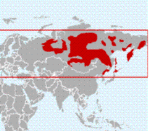 SKC Films Library SKC Films Library |
| SKC Films Library >> Science >> Zoology >> Mammals >> Order Carnivora >> Family Mustelidae |
| Sable Martes zibellina Description Sables are 14-22 inches long, not including the tail, which is about 5 inches long, and weigh 25-63 ounces; males are larger than females. The fur is light to dark brown, with a light patch of fur on the throat. Unlike many other animals that live in Arctic-type environments, the sable's fur does not turn white in the winter. Distribution and Habitat The sable is found across northern Asia, throughout Siberia into northern China, and on the island of Hokkaido, Japan. It lives in dense taiga forests, flatlands, and mountain regions, but not on barren mountain tops.
Habits and Behaviors The sable is almost exclusively terrestrial, although it does have the ability to climb if absolutely necessary. It generally builds a den on the forest floor among tree roots, and is diurnal by nature. Diet Sables use their senses of smell and hearing to hunt for small prey, primarily rodents and small birds. It will also take bird eggs and fish, as well as berries, cedar nuts and other vegetation when prey is scarce. During extreme weather conditions it will store food in its den. Reproduction The breeding season runs from mid-June through mid-August. Males compete for females, with violent battles common where ranges overlap. Up to 7 offspring are born after a total gestation time of 275 days, of which only 25-30 days are in the uterus. The young are born hairless and blind; the eyes will open at 30-36 days, weaning will occur at about 7 weeks, and sexual maturity is reached at about 2-1/2 years. Sables have a lifespan of up to 8 years in the wild. Other Information Sable fur has been used by man since prehistoric times. By the Middle Ages the traditional range of the sable had been greatly reduced, and sable fur became so expensive that it was only available to royalty and the very rich. Sables are still relatively rare today, but restrictions on the hunting of them have allowed their populations to stabilize, and sable fur remains one of the most expensive on the market. Scientific Classification phylum Chordata SOURCE |
| SKC Films Library >> Science >> Zoology >> Mammals >> Order Carnivora
>> Family
Mustelidae This page was last updated on May 20, 2017. |
